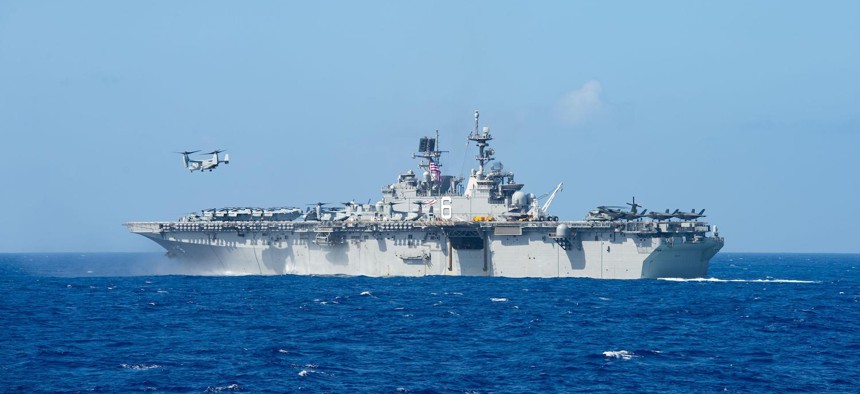
An MV-22B Osprey tiltrotor aircraft, assigned to the “Dragons” of Marine Medium-Tiltrotor Squadron (VMM) 265, 31st Marine Expeditionary Unit, prepares to land on the flight deck of the amphibious assault ship USS America (LHA 6) Feb. 15, 2020. U.S. Navy / Mass Communication Specialist 3rd Class Nicholas V. Huynh
EXCLUSIVE: Navy Won’t Publicly Release Results of Amphibious Ship Study
The study, which had been delayed for months, has been sent to lawmakers.
The long-awaited Navy study to determine the future makeup of the U.S. amphibious warship fleet has finally made it to Congress, but don’t hold your breath for the results: they’re classified.
The Navy sent the Amphibious Force Requirements Study to the Congressional defense committees on Dec. 28, Lt. Gabrielle Dimaapi, a spokeswoman for the Navy secretary, said in an email statement Friday to Defense One.
The study was “closely coordinated with the Office of the Secretary of Defense Cost Analysis and Program Evaluation and Office of Management and Budget prior to providing it to Congress,” Dimaapi said. It “assessed the risk associated with the size and composition of the future amphibious warship fleet. It focused on both traditional and planned amphibious warships and platforms.”
Though the service “is not planning to release an unclassified summary of the report,” the results “will be incorporated into an ongoing battle force ship assessment that will be published later this year,” she said.
But it’s unclear how much of the amphibious ship study results will be revealed in the battle force ship assessment. Last year’s assessment was also classified, and only the top-level number of 373 ships was released, U.S. Naval Institute News reported.
Navy Secretary Carlos Del Toro has been promising for months that the amphibious ship study would be ready in a matter of weeks, even testifying to that during a May Senate Armed Services Committee hearing. When no study materialized, Sens. Tim Kaine, D-Va., and Roger Wicker, R-Miss., sent a letter in November to Del Toro asking for the study. In early December, the secretary told reporters the document was almost ready, but was still “being briefed to senior leadership.”
Amphibious ships are purchased, operated, and maintained by the Navy, mainly to bring Marine Corps forces on deployments and other missions.
Marine Corps officials have said their service needs a minimum of 31 amphibious ships: 10 big-deck amphibious assault ships and 21 amphibious transport dock ships. Congress agreed, and set that minimum number in the 2023 National Defense Authorization Act. It also required that the Marine commandant be consulted “on major decisions directly concerning Marine Corps aviation or amphibious force structure and capability.”
Marine officials have also said they need 35 of the future light amphibious warships, or LAWs. The LAW is key to the service’s Expeditionary Advanced Base Operations concept, and they would move the new Marine Littoral Regiments around the Pacific to counter or deny Chinese military activities, Gen. Eric Smith, the Corps’ assistant commandant, said at last year’s Sea Air Space conference.
The LAW is intended to complement the larger LHA and LPD amphibs, to be a more efficient way to transport Marines around the first island chain, Smith said.
But some argue that the comparatively slow and lightly armed LAWs would be so unsuited for combat that they throw the entire EABO concept into question.
